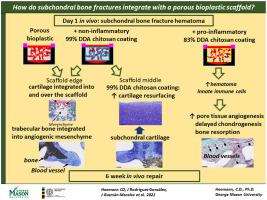Bioactive Materials ( IF 18.9 ) Pub Date : 2021-09-16 , DOI: 10.1016/j.bioactmat.2021.09.012 Caroline D Hoemann 1, 2 , Javier Rodríguez González 1 , Jessica Guzmán-Morales 1 , Gaoping Chen 1 , Ebrahim Jalali Dil 1, 3 , Basil D Favis 1, 3

|
This study tested whether osseous integration into poly (ε-caprolactone) (PCL) bioplastic scaffolds with fully-interconnecting 155 ± 8 μm pores is enhanced by an adhesive, non-inflammatory 99% degree of deacetylation (DDA) chitosan coating (99-PCL), or further incorporation of pro-inflammatory 83% DDA chitosan microparticles (83-99-PCL) to accelerate angiogenesis. New Zealand White rabbit osteochondral knee defects were press-fit with PCL, 99-PCL, 83-99-PCL, or allowed to bleed (drill-only). Between day 1 and 6 weeks of repair, drill-only defects repaired by endochondral ossification, with an 8-fold higher bone volume fraction (BVF) versus initial defects, compared to a 2-fold (99-PCL), 1.1-fold (PCL), or 0.4-fold (83-99-PCL) change in BVF. Hematoma innate immune cells swarmed to 83-99-PCL, elicited angiogenesis throughout the pores and induced slight bone resorption. PCL and 99-PCL pores were variably filled with cartilage or avascular mesenchyme near the bone plate, or angiogenic mesenchyme into which repairing trabecular bone infiltrated up to 1 mm deep. More repair cartilage covered the 99-PCL scaffold (65%) than PCL (18%) or 83-99-PCL (0%) (p < 0.005). We report the novel finding that non-inflammatory chitosan coatings promoted cartilage infiltration into and over a bioplastic scaffold, and were compatible with trabecular bone integration. This study also revealed that in vitro osteogenesis assays have limited ability to predict osseous integration into porous scaffolds, because (1) in vivo, woven bone integrates from the leading edge of regenerating trabecular bone and not from mesenchymal cells adhering to scaffold surfaces, and (2) bioactive coatings that attract inflammatory cells induce bone resorption.
中文翻译:

具有独特先天免疫生物活性的壳聚糖涂层在具有受控互连孔径的聚己内酯支架中不同地刺激血管生成、成骨和软骨生成
本研究测试了具有完全互连的 155 ± 8 μm 孔的聚(ε-己内酯)(PCL)生物塑料支架的骨整合是否通过粘性、非炎症 99% 脱乙酰度(DDA)壳聚糖涂层(99-PCL)增强),或进一步掺入促炎性 83% DDA 壳聚糖微粒 (83-99-PCL) 以加速血管生成。新西兰白兔骨软骨膝关节缺损采用 PCL、99-PCL、83-99-PCL 压配合,或允许流血(仅钻孔)。在修复的第 1 天和第 6 周之间,通过软骨内骨化修复的仅钻孔缺损的骨体积分数 (BVF) 比初始缺损高 8 倍,而初始缺损是 2 倍 (99-PCL)、1.1 倍。 PCL) 或 BVF 的 0.4 倍 (83-99-PCL) 变化。血肿先天免疫细胞蜂拥而至 83-99-PCL,引起整个毛孔的血管生成并诱导轻微的骨吸收。PCL 和 99-PCL 孔不同程度地充满软骨或骨板附近的无血管间充质,或血管生成间充质,修复骨小梁渗透到 1 mm 深。与 PCL (18%) 或 83-99-PCL (0%) 相比,99-PCL 支架 (65%) 的修复软骨更多 (p < 0.005)。我们报告了一项新发现,即非炎性壳聚糖涂层促进软骨浸润到生物塑料支架中,并与骨小梁整合相容。本研究还表明 与 PCL (18%) 或 83-99-PCL (0%) 相比,99-PCL 支架 (65%) 的修复软骨更多 (p < 0.005)。我们报告了一项新发现,即非炎性壳聚糖涂层促进软骨浸润到生物塑料支架中,并与骨小梁整合相容。本研究还表明 与 PCL (18%) 或 83-99-PCL (0%) 相比,99-PCL 支架 (65%) 的修复软骨更多 (p < 0.005)。我们报告了一项新发现,即非炎性壳聚糖涂层促进软骨浸润到生物塑料支架中,并与骨小梁整合相容。本研究还表明体外成骨分析预测骨整合到多孔支架的能力有限,因为 (1)在体内,编织骨从再生骨小梁的前缘整合,而不是从粘附在支架表面的间充质细胞整合,以及 (2) 生物活性涂层吸引炎症细胞诱导骨吸收。



























 京公网安备 11010802027423号
京公网安备 11010802027423号